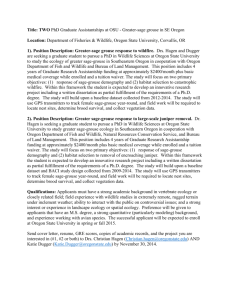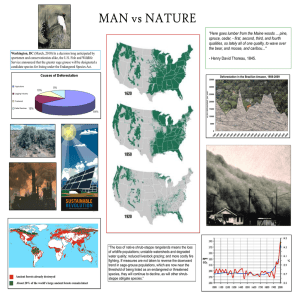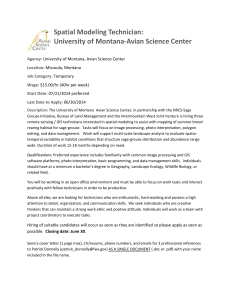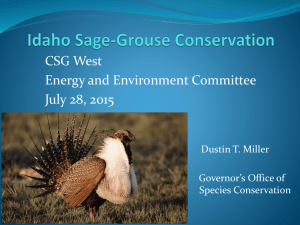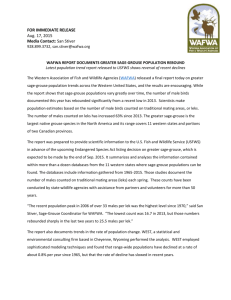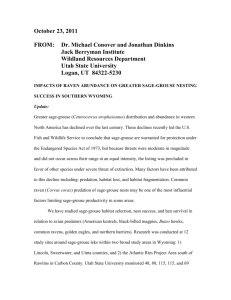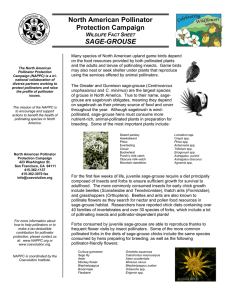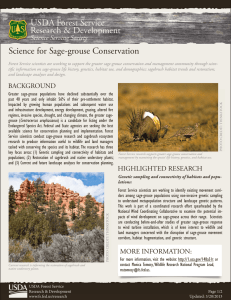Utilizing hunter harvest effort to survey for wildlife disease: A... study of West Nile virus in greater sage ‐
advertisement
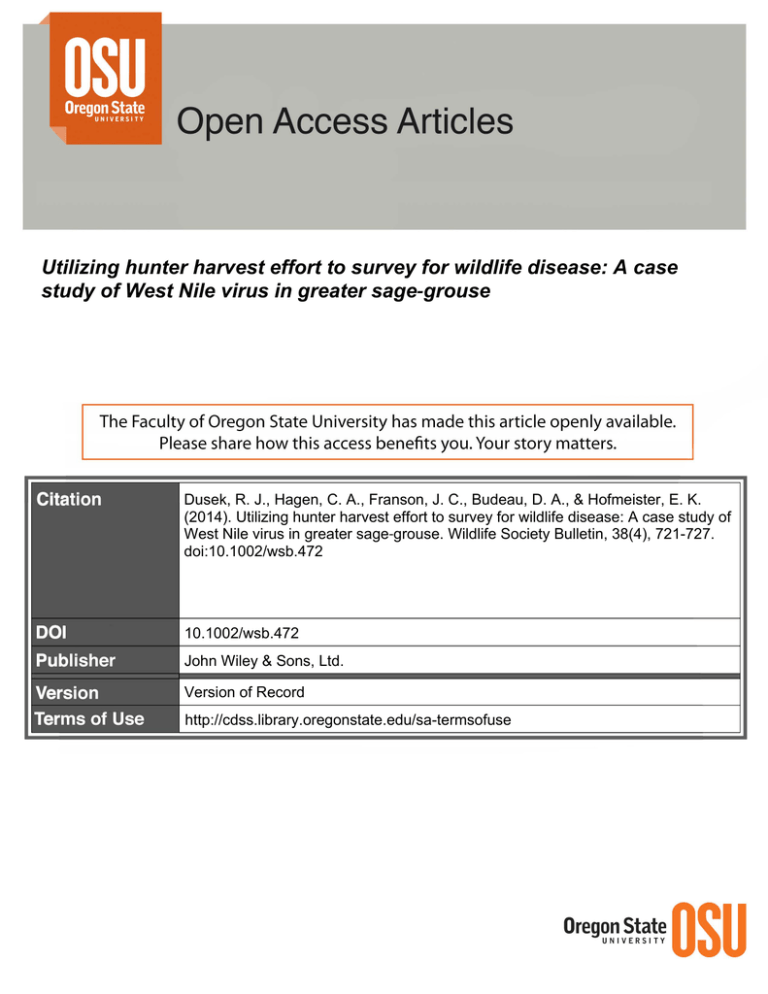
Utilizing hunter harvest effort to survey for wildlife disease: A case study of West Nile virus in greater sage‐grouse Dusek, R. J., Hagen, C. A., Franson, J. C., Budeau, D. A., & Hofmeister, E. K. (2014). Utilizing hunter harvest effort to survey for wildlife disease: A case study of West Nile virus in greater sage‐grouse. Wildlife Society Bulletin, 38(4), 721-727. doi:10.1002/wsb.472 10.1002/wsb.472 John Wiley & Sons, Ltd. Version of Record http://cdss.library.oregonstate.edu/sa-termsofuse Wildlife Society Bulletin 38(4):721–727; 2014; DOI: 10.1002/wsb.472 Original Article Utilizing Hunter Harvest Effort to Survey for Wildlife Disease: A Case Study of West Nile Virus in Greater Sage-Grouse ROBERT J. DUSEK,1 United States Geological Survey, National Wildlife Health Center, 6006 Schroeder Road, Madison, WI 53711, USA CHRISTIAN A. HAGEN,2 Oregon Department of Fish and Wildlife, 61374 Parrell Road, Bend, OR 97702, USA J. CHRISTIAN FRANSON, United States Geological Survey, National Wildlife Health Center, 6006 Schroeder Road, Madison, WI 53711, USA DAVID A. BUDEAU, Oregon Department of Fish and Wildlife, 4034 Fairview Industrial Drive SE, Salem, OR 97302, USA ERIK K. HOFMEISTER, United States Geological Survey, National Wildlife Health Center, 6006 Schroeder Road, Madison, WI 53711, USA ABSTRACT Greater sage-grouse (Centrocercus urophasianus; sage-grouse) are highly susceptible to infection with West Nile virus (WNV), with substantial mortality reported in wild populations and in experimentally infected birds. Although sage-grouse are hunted throughout much of their range, they have also recently been considered for protection under the Endangered Species Act. We used blood samples collected on filter-paper strips during the 2006–2010 Oregon, USA, annual sage-grouse hunt to survey for specific WNV-neutralizing antibodies that indicate a previous infection with WNV. During this period, hunters submitted 1,880 blood samples from sagegrouse they harvested. Samples obtained were proportional for all 12 Oregon sage-grouse hunting units. Laboratory testing of 1,839 samples by the WNV epitope-blocking enzyme-linked immunosorbent assay (bELISA) followed by plaque reduction neutralization test on bELISA-positive samples yielded 19 (1%) and 1 (0.05%) positive samples, respectively. These data provided early baseline information for future comparisons regarding the prevalence of WNV-specific neutralizing antibodies in sage-grouse in Oregon. This methodology may provide other states where sage-grouse (or other species) populations are hunted and where WNV constitutes a species conservation concern with a viable option to track the relative prevalence of the virus in populations. Published 2014. This article is a U.S. Government work and is in the public domain in the USA. KEY WORDS Centrocercus urophasianus, filter-paper strip, greater sage-grouse, hunter harvest, Oregon, West Nile virus. Hunter harvest surveys have been historically used by wildlife management agencies to obtain biological information about game populations (Connelly et al. 2012). With recognition of the importance of wildlife health and potential for zoonotic diseases in wildlife, hunters have also been asked to participate in wildlife health studies regarding the species they harvest (Drew et al. 1992, Schmitt et al. 1997, Dusek et al. 2009). The importance of hunter surveys in the early detection and spread of wildlife diseases became evident in the 1990s. In California, USA, investigators relied, in part, on serum samples from hunter-killed animals to determine the prevalence of brucellosis in the wildlife species tested (Drew et al. 1992). Hunters can also play an important role in the detection of wildlife disease or disease events through reporting of unique events or observations. Bovine tuberculosis was first detected in white-tailed deer (Odocoileus Received: 17 September 2012; Accepted: 7 May 2014 Published: 20 August 2014 1 E-mail: rdusek@usgs.gov Present address: Oregon State University, 500 SW Bond Street, Suite 107, Bend, OR 97702, USA 2 Dusek et al. Harvest Survey for West Nile Virus virginianus) in Michigan, USA, after hunters reported gross lesions observed in the animals they had harvested (Schmitt et al. 1997). Follow-up investigations, again relying on hunter-killed deer, identified the first epidemic occurrence of this disease in wild cervids in North America (Schmitt et al. 1997). In Wisconsin, USA, chronic wasting disease was first reported in 2001 via a hunter-killed white-tailed deer surveillance program set up for that specific purpose (Joly et al. 2003). This finding represented an important range expansion of that disease because it was the first detection in cervids east of the Mississippi River (Joly et al. 2003). More recently avian influenza surveillance programs have relied, in part, on hunter-killed waterfowl from both sport and subsistence hunters as an important resource for obtaining samples (Ip et al. 2008, Dusek et al. 2009). In 2011 greater sage-grouse (Centrocercus urophasianus; sage-grouse) were legally harvested in 10 of 11 states in which they occur (Reese and Connelly 2011). Contemporary sage-grouse hunting seasons vary by timing, length, bag limits, and licensing processes. Sage-grouse hunting in Oregon, USA, is by permit only, and as a result is closely monitored. Harvest was permitted in 12 of 21 wildlife management units, which contain approximately 75% of the state’s sage-grouse population, and hunting is regulated to 721 ensure that 5% of the hunted population is harvested (Hagen 2011). The current hunting season is 9 days long and occurs in the second week of September. An average (1992–2011) of 1,217 permits has been annually authorized, allowing hunters to take up to 2 birds during the season (D. Budeau, Oregon Department of Fish and Wildlife [ODFW], unpublished data). From 1995 to 2011 the average number of permits issued and sage-grouse reported harvested were 912 permits and 890, respectively (D. Budeau, ODFW, unpublished data). The ODFW monitored sage-grouse harvest by collecting biological data from the wings of hunter-harvested sage-grouse and via phone (1995–2003) and postcard surveys (beginning in 2004) of successful permit applicants (Hagen and Loughin 2008). West Nile virus (WNV) was first documented in sagegrouse in Montana, USA, in summer 2003 (Naugle et al. 2004). Since then sage-grouse WNV-related mortality has been reported sporadically across the species’ range (U.S. Geological Survey [USGS] 2006). Laboratory studies of WNV infection in sage-grouse indicated that the virus caused 100% mortality in experimentally infected birds (Clark et al. 2006). However, one study has reported individual wild sage-grouse that survived WNV infection based on detection of WNV-neutralizing antibodies in live birds (Walker et al. 2007). The transmission season for WNV in sage-grouse has been reported to be approximately mid-May through midSeptember (Walker and Naugle 2011). Documented mortality events among sage-grouse due to WNV infection generally have occurred in July and August (Naugle et al. 2004, 2005; USGS 2006). The timing of the transmission season varies and is dependent on environmental conditions that would impact WNV vector mosquito (Culicidae) activity and distribution (Naugle et al. 2005). In Oregon, a WNV-induced mortality event was detected in sage-grouse in July 2006. This event was accompanied by individual WNV cases and numerous anecdotal reports from ranchers about the disappearance of sage-grouse from their properties (USGS 2006). Because of the potential impact to local sage-grouse populations, the ODFW and the USGS National Wildlife Health Center (NWHC) began a monitoring program to better understand the prevalence of specific WNV-neutralizing antibodies in sage-grouse populations throughout Oregon. The ODFW was interested in using these data to make informed decisions regarding the conservation status of the sage-grouse, because this species is currently listed as a candidate for protection under the Federal Endangered Species Act (U.S. Fish and Wildlife Service 2010). Using Oregon’s permit system for sage-grouse, we instituted a program in 2006 to collect voluntary blood samples using filter-paper strips from hunter-harvested birds for use in a state-wide survey of WNV antibody prevalence in Oregon sage-grouse. We also examined our ability to detect WNV antibodies from filter-paper strips when storage conditions and blood absorption deviated from manufacturer’s recommendations, as might be encountered 722 when stakeholders are engaged in collecting biological samples. STUDY AREA We conducted our study across 12 wildlife management units in southeastern Oregon during 2006–2010 (Fig. 1). This region included Baker, Crook, Deschutes, Lake, Harney, and Malheur counties. Samples were collected at elevations that ranged from 1,200 m to 2,500 m where the topography was generally flat to rolling terrain. Vegetation in the region included various sagebrush (Artemisia spp.) species co-dominated by perennial bunch-grasses depending upon precipitation and elevation, and western juniper (Juniperus occidentalis) occurred at various densities at higher elevations (Johnson and O’Neil 2001). Climate data from the study area included similar mean minimum and maximum temperatures for Malheur and Harney counties (town of Fields ¼ 3.08 and 17.18C; 1994–2011) and mean total annual precipitation of 23.0 cm (1994–2012) at Fields, Oregon (Harney County; Western Regional Climate Center, http:// www.wrcc.dri.edu/). MATERIALS AND METHODS Field Sampling Through the Oregon sage-grouse hunt permitting process, we distributed filter-paper strips (Nobuto blood filter strips; Advantec MFS, Inc., Dublin, CA [subsidiary of Toyo Roshi Kaisha, Ltd., Tokyo, Japan]), sampling instructions, and a postage-paid envelope for submitting wings and Nobuto strips to successful applicants. We sent one Nobuto strip to Figure 1. State of Oregon wildlife management units with greater sagegrouse (Centrocercus urophasianus) permit-only hunting and current greater sage-grouse distribution detailed. Blood samples to determine presence of specific West Nile virus-neutralizing antibodies were obtained (using filter paper strips) from hunter-killed greater sage-grouse from all 12 greater sagegrouse hunt units during 2006–2010. Map was created in ArcMap 10.0 (ESRI, Redlands, CA). Hunt unit layer was obtained from the Oregon Department of Fish and Wildlife Natural Resources Information Management Program (http://nrimp.dfw.state.or.us/nrimp/default.aspx?p¼259). Greater sage-grouse range layer was obtained from http://sagemap.wr. usgs.gov/GISData.aspx. Wildlife Society Bulletin 38(4) each successful applicant in 2006 because of limited supplies from the distributors. In 2007 through 2010 we sent each successful applicant 2 strips and a visual example of the correct and incorrect application of blood to the Nobuto strip (Fig. 2). From each individual sage-grouse harvested, we asked successful hunters to collect a single blood sample on each strip, air-dry it, and store each strip individually in the coin envelopes provided. Hunters were then asked to mail the collected sample with the corresponding wing to ODFW. Received samples were stored frozen (208C) until shipped on frozen ice packs to the NWHC. Wings were later aged and sexed by plumage characteristics at the annual Oregon sage-grouse wing-bee (Crunden 1963). Sample Quality Samples we received from hunters were highly variable in the amount of blood absorption on the strip; therefore, we evaluated returned Nobuto strips beginning in 2007 for the extent of blood absorption. We classified blood absorption based on coverage on the Nobuto strip and how thoroughly blood was absorbed. We also noted any inappropriate use of the strip (i.e., absorbing blood on the wrong end). Categories included 0–25%, 26–50%, 51–75%, and 75–100% blood coverage. Control Samples To evaluate the accuracy of our blood sampling technique, we compared test results from Nobuto strips prepared with blood obtained from commercially supplied partridge (Alectoris chukar A. rufa) that had been experimentally infected with WNV (as part of a separate study) against those of serum collected from the same birds. We obtained day-old partridge and raised them in a biosafety-level-3 isolation facility until they were 6 weeks of age, then infected them with 105 plaque-forming units of a low-passage 1999 American crow (Corvus brachyrhynchos) isolate of WNV (NWHC no. 16399-3). The birds were held for an additional 14 days and then euthanized, at which time blood samples were obtained for our study. From up to 7 infected birds, we obtained multiple Nobuto strip samples that were of 3 types: a 100%-absorbed sample per manufacturer’s instructions, a 50%-absorbed sample, and a “blot” sample in which the strip was blotted against a blood clot that formed within the sample. These “blot” samples were not fully absorbed through the Nobuto strips and were highly variable regarding the amount of blood absorbed. These 3 types were meant to represent a range of samples obtained from hunters untrained or only briefly trained (by example images) in this method of blood collection. After collection, we randomly assigned samples from each bird to one of 2 groups and stored them either frozen at 208C or at room temperature (RT; approx. 18–248C). We tested single Nobuto strips for the presence of detectable WNV antibodies at 14, 90, and 180 days post-collection (dpc) for those stored at RT, and at 90 and 180 dpc from those stored at 208C. We also stored serum from each partridge at 208C and tested it at 14 dpc. Laboratory Methods We eluted Nobuto strips per manufacturer’s instructions to a dilution of 1:10 except in 2009–2010 when they were eluted to a dilution of 1:20. Dilutions were approximate because all strips were treated similarly, regardless of how much blood was absorbed on the strip. For the detection of anti-WNV antibodies, we heat-inactivated eluates at 568C for 30 min, then screened each sample by the WNV epitope-blocking enzyme-linked immunosorbent assay (bELISA) using WNV/Kunjin NS1 specific monoclonal antibody (MAb 3.112G; Millipore Corp, Billerica, MA; Blitvich et al. 2003). Figure 2. Correct and incorrect applications of blood to Nobuto strips. This image was provided to Oregon, USA, sage-grouse hunters with the Nobuto strips beginning in 2007, so that we could survey from 2006 to 2010 for specific West Nile virus-neutralizing antibodies. Dusek et al. Harvest Survey for West Nile Virus 723 Using this bELISA, all results with 30% inhibition are considered positive for anti-WNV antibodies. We further tested all bELISA samples with 30% inhibition by plaque reduction neutralization test (PRNT) to confirm the presence of WNV-neutralizing antibodies. We used WNV isolate NWHC 16933-3 diluted in BA-1 (M199 medium with Hank’s salts and Tris–HCl, containing 0.008% sodium bicarbonate, 1% bovine serum albumin, 20% fetal bovine serum, 1,000 U/mL penicillin and streptomycin, and 1 mg/mL amphotericin B) so that control wells contained between 60 and 100 plaques (Beaty et al. 1995). We considered sera that exhibited a 90% inhibition of the test dose of virus at a 1:20 dilution as antibody-positive (PRNT90). We further titered PRNT90-positive samples by serially diluting samples in 2-fold increments until an endpoint titer was determined. Harvest Survey We sent postcard harvest surveys to all successful sage-grouse hunt applicants. Based on the response rates, we estimated the number of individuals who actually hunted. We extrapolated the total harvest using response rates (e.g., surveys mailed/response response ¼ estimate). RESULTS Field Sampling From 2006 to 2010, we obtained 1,880 Nobuto strip samples from sage-grouse hunters in Oregon and tested 1,839. Samples not tested were inappropriately used or were lost after submission. For the 2008–2010 sage-grouse hunting seasons, 74.6% of wing/Nobuto strip envelopes returned by hunters through the U.S. mail were received within 14 days of the end of the season and 99.6% were received within 90 days of the end of the season. The bELISA results indicated 19 Nobuto strips were positive for antibodies to WNV and 1 of these samples was confirmed positive by PRNT90 (Titer ¼ 1:80; Table 1). Of the 19 bELISA-positive samples, 14 were female (6 hatch year, 7 after hatch year, 1 unknown age), and 3 were male (2 hatch year, 1 after hatch year). Two birds were of unknown age and sex. No birds that were aged second year were bELISA-positive. The individual that was PRNT90-positive was a hatch year male. Table 1. Results from Nobuto strip-eluted samples collected by Oregon, USA, greater sage-grouse (Centrocercus urophasianus) hunters from 2006 to 2010 and tested by West Nile virus epitope blocking enzyme linked immunosorbent assay (bELISA) and plaque reduction neutralization testing (PRNT) of bELISA-positive samples. Year Sample type 2006 2007 2008 2009 2010 Total Nobuto strips tested bELISA-positive PRNT-positive 307 5 393 10 372 2 1a 380 1 387 1 1,839 19 1 a Titer ¼ 1:80. 724 Hunter Response From 2006 through 2010, hunter response rate to postcard surveys ranged from 68% to 78%, and an average of 511 (SD ¼ 81) wings were sent in for examination (Table 2). Based on participation of postcard survey respondents, the response rate for submitting Nobuto strips between 2007 and 2010 averaged 71% (SD ¼ 0.04) and 83% (SD ¼ 0.02) as a proportion of wings returned. However, as a proportion of the average total harvest, the Nobuto response rate was 52% (SD ¼ 0.01; 2007 through 2010). When a single Nobuto strip was provided to each hunter, we obtained samples from 28% of the estimated total harvest; and when 2 strips were provided, we obtained samples from 51% to 54% of the harvested birds (Table 2). We obtained a consistent age and sex distribution among samples that had both a wing and a Nobuto strip submitted (Table 3). We believe the response rates and samples were representative of the distribution of hunted sage-grouse populations in Oregon for the sampling period (Fig. 1 and Table 4). Sample Quality We evaluated 1,529 Nobuto strips for sample quality. Sixtyone percent had blood absorbed on >75% of the strip, 26% were 50–75% absorbed, 9% were 25–50% absorbed, and 4% had <25% blood absorption. Of samples with absorption of >75% (the best quality sample) 10 were bELISA-positive with one of those also being PRNT90-positive. Of strips with 50–75% absorption, four were bELISA-positive and no strips categorized as 25–50% blood absorption or <25% blood absorption had positive bELISA results. The remaining 5 Nobuto strips that were bELISA-positive were not evaluated for sample quality. Control Samples All 100%-absorbed partridge control samples tested positive for WNV antibodies by bELISA and PRNT at all storage time points and conditions except at RT for 180 dpc (n ¼ 7 for RT at 14 and 90 dpc, n ¼ 6 for all others). For samples stored at RT for 180 dpc, 2 of 6 (33%) tested negative by bELISA and 3 of 6 (50%) tested negative by PRNT90. One of the bELISA-negative samples tested positive by PRNT90. All of the 50%-absorbed samples tested positive by bELISA and PRNT90 at all storage time points and conditions except when stored at RT for 180 dpc (n ¼ 6 for RT at 14 dpc, n ¼ 5 for all others). Two of 5 (40%) samples stored at RT for 180 dpc tested negative by bELISA and 4 of 4 (100%) tested negative by PRNT. One sample that tested negative by bELISA with a resulting bELISA value of <10 was not tested by PRNT90. Seven of 7 (100%) blot samples stored at RT for 14 dpc and stored at 208C for 90 and 180 dpc were positive by bELISA. Three of 7 (43%) and 6 of 7 (86%) blot samples stored at RT for 90 and 180 dpc tested negative by bELISA. One of 7 (14%) blot samples stored at RT and tested by PRNT90 at 14 dpc was negative, 5 of 7 (71%) tested at 90 dpc were negative, and 1 of 1 tested at 180 dpc was negative. Two of 7 (29%) and 0 of 7 (0%) blot samples stored at 208C for 90 and 180 dpc were negative, respectively, when tested by Wildlife Society Bulletin 38(4) Table 2. Annual response rate of Nobuto strip-sample submission to test for West Nile virus in greater sage-grouse (Centrocercus urophasianus) in Oregon, USA, reported as a proportion to postcard survey respondents (actual responses) estimates from postcard survey (estimated from survey), and hunter wingreturns, from 2006 to 2010. Year Response category 2008 2009 2010 x 583 186 537 0.92 478 196 502 1.05 569 230 613 1.08 511 149 555 1.09 550 203 590 1.07 836 267 770 70% 678 278 712 71% 727 294 783 78% 686 200 745 74% 764 282 820 72% 485 397 393 443 381 372 493 399 380 463 393 387 511 376 368 2006 Actual responses Hunted Did not hunt Birds harvested Birds/hunter Estimated from survey Hunted Did not hunt Estimated harvest Hunter response rate Empirical samples Wings received Nobuto strips received Nobuto strips tested Nobuto response rates Postcard Wing returns Overall a 2007 a 611 253 744 1.22 894 370 1,088 68% 669 310 307 0.42 0.46 0.28 0.74 0.82 0.52 0.76 0.86 0.54 0.65 0.81 0.51 0.71 0.85 0.53 0.64 0.74 0.46 A single Nobuto strip was sent to each hunter in 2006, but two were sent in 2007–2010. Table 3. Age (HY ¼ hatch year, SY ¼ second year, AHY ¼ after hatch year) and gender of hunter-harvested greater sage-grouse (Centrocercus urophasianus) sampled for West Nile virus with Nobuto strips in Oregon, USA, 2006–2010. Females Males Year HY SY AHY HY SY AHY Unknown Total 2006 2007 2008 2009 2010 Total 69 52 86 99 101 407 9 22 14 16 16 77 66 151 95 78 117 507 59 45 89 103 72 368 3 2 0 0 2 7 74 102 45 67 68 356 27 19 43 17 11 117 307 393 372 380 387 1,839 Table 4. Geographic distribution of Nobuto strip samples collected and summary of positive results according to hunt unit and proportion of estimated highest number of greater sage-grouse (Centrocercus urophasianus) that could have been harvested between 2006 and 2010. Permits available/yra Hunt unit Sumpter Lookout Mountain Beulah Malheur River Owyhee Whitehorse Steens Beaty’s Butte Juniper Silvies Wagontire Warner Unknown Total No. samples tested Proportion of hunted population sampledb (%) 4 12 163 104 89 433 169 284 137 45 87 283 29 1,839 4.0 12.0 10.9 10.4 11.9 19.2 21.1 16.2 13.7 22.5 15.8 21.8 10 10 150 105 80 230 97 180 100 20 58 150 1,190 16.3 bELISAc-positive PRNT90d-positive 1 2 1 3 3 2 1 1 2 4 19 1 a Average based on annual permits authorized from 2006 to 2010. Hunted population is calculated by multiplying the total no. of permits available per year by the no. of birds authorized to take per year (2/permit issued) by the no. of years of this study (5). It represents the hypothetical max. no. of birds that could have been harvested over the period of this study. c bELISA—epitope blocking enzyme linked immunosorbent assay. d PRNT90—plaque reduction neutralization test. Samples that exhibited a 90% inhibition of the test dose of the virus at a 1:20 dilution were considered positive. b Dusek et al. Harvest Survey for West Nile Virus 725 PRNT90. All serum results for experimentally infected partridge were positive by both bELISA and PRNT. DISCUSSION We found a low prevalence of WNV antibodies in hunterharvested sage-grouse in Oregon. Walker et al. (2007) also found low prevalence in sage-grouse populations in Montana and Wyoming, where 8 of 167 sage-grouse sampled tested positive for WNV-neutralizing antibodies (Walker et al. 2007). High mortality among infected wild birds may explain low rates of antibody detection found by Walker et al. (2007) and in our study (Clark et al. 2006). Specific WNV-neutralizing antibodies develop 7–10 days after infection and can last for >1 year (Langevin et al. 2001, Gibbs et al. 2005). Managers can use the prevalence of antibodies in a harvested population as an index of the proportion of animals in that population still alive following the infection that resulted in the development of the antibodies tested for (Mueller-Anneling et al. 2000). Although the low prevalence of WNV antibodies in our study precluded meaningful comparisons over time and space, our data from 2006 to 2010 provides a baseline, representing an early period of time after WNV was first detected in sage-grouse in 2003, to which future serosurveys can be compared. This methodology could also augment serological testing of live sage-grouse for WNV antibodies and would complement other surveys that monitor WNV mortality to better understand long-term impacts of this disease on populations (Walker and Naugle 2011). Implementing surveys such as the one we have described could greatly assist wildlife managers in identifying patterns of disease across broad landscapes. This information can also be useful to the public and veterinary health officials to monitor the spread of disease or may lead to efforts to attempt to eliminate or reduce a disease in a population (Drew et al. 1992, Schmitt et al. 1997, Joly et al. 2003). Hunter-collected biological samples such as wings have helped with management of sage-grouse in Oregon; these data, in conjunction with other population data such as lek surveys and age-ratios (i.e., from wing data), have enabled wildlife managers in Oregon to efficiently monitor population dynamics, and to establish hunting regulations and bag limits at regional scales (Hagen and Loughin 2008). In our study, hunter-collected blood samples enabled us to test more birds from a broader portion of their range than would have been possible from deploying field crews to live-capture grouse. Other states have successfully used hunter-collected blood samples to identify large-scale trends in other diseases (Mueller-Anneling et al. 2000). Although Nobuto strip sampling has been voluntary in Oregon, hunters have shown an interest in the management of the species and by providing these data have allowed us to gather disease data on >50% of sage-grouse harvested annually, and spatially represented across most of the sage-grouse range in Oregon. The permit-only hunting opportunity facilitated a relatively easy method to expand on the wing collection program to include these blood samples. 726 Hunter participation in disease surveillance programs can be affected by a number of variables. In our study, postharvest handling of samples by the hunters may have affected sample quality. Nobuto strips have been previously found to be relatively stable for a period of months for detection of antibodies to avian influenza virus under a variety of storage conditions (Dusek et al. 2011). We found that freezing the strips at 208C after collection was the preferred method; however, our findings with partridge blood indicated that Nobuto strips could be held up to 90 days at room temperature without compromising our ability to detect WNV antibodies by bELISA or PRNT. More than 99% of our sage-grouse samples were submitted to ODFW within 90 days after the season ended and 87% of Nobuto strips were absorbed to 50% or greater, suggesting that we would be able to detect positive samples. In addition, most wings received by ODFW had been frozen shortly after harvest. Because Nobuto strips were usually placed in the same envelope with the wing, it is likely that these were frozen also. Upon arrival at the ODFW laboratory in Hines, Oregon (upon receipt with the sage-grouse wings) and at the NWHC (as they arrived at the laboratory for assay), sample handling was controlled. We speculate that any degradation of the samples from being stored at ambient temperatures is likely to cease at the point they were frozen. However, some degradation may have occurred and the bELISA results and PRNT antibody titers we report may be an underestimate of the true prevalence. Perhaps the reason we detected only a single WNV PRNT positive is because this test requires functional antibodies to neutralize WNV, and any degradation due to storage conditions may have precluded our ability to detect neutralizing antibodies. Understanding the limitations of using hunters to collect samples for disease detection and the inferences that can be drawn from such data is imperative. However, refining our methodology may enable an expansion of disease monitoring for other harvested wildlife populations in the future. Refinements may include 1) training of hunters on proper sample collection (in our case we used a photograph), 2) detailed instructions regarding field preservation of samples, 3) prompt submission of samples to the state wildlife agency, 4) discarding samples with <50% absorption of blood on the strip and consider discarding those submitted >90 days after collection, and 5) maintaining consistency in sampling period. ACKNOWLEDGMENTS Numerous volunteers and now retired Oregon Department of Fish and Wildlife (ODFW) staff have assisted with classification of wings at the annual Oregon sage-grouse wing-bee over the years. Most recently we would like to acknowledge the efforts of ODFW staff at the wing-bees: R. Klus, C. Foster, P. Milburn, N. Myatt, A. Larkins, M. Hedrick, S. Torland, and B. Ratliff. B. Reishus assisted with the mailings and wing-bees during the survey period, and L. Draper was diligent in coordinating with the post office and picking up the wings. C. Braun has provided training and quality control for wing-bee data collection for several years Wildlife Society Bulletin 38(4) and those efforts have greatly improved the quality of the data. We would also like to thank L. Leppert, Y. Hernandez, L. Clark, and M. Lund for analysis of laboratory samples; and K. Prestby for creating the map. B. Walker and one anonymous reviewer provided a number of suggestions that improved the quality of this manuscript. Use of trade or product names does not imply endorsement by the United States government. LITERATURE CITED Beaty, B., C. Calisher, and R. Shope. 1995. Arboviruses. Pages 204–205 in E. H. Lennette, D. A. Lennette, and E. T. Lennette, editors. Diagnostic procedures for viral, rickettsial, and chlamydial infections. Seventh edition. American Public Health Association, Washington, D.C., USA. Blitvich, B. J., N. L. Marlenee, R. A. Hall, C. H. Calisher, R. A. Bowen, J. T. Roehrig, N. Komar, S. A. Langevin, and B. J. Beaty. 2003. Epitopeblocking enzyme linked immunosorbent assays for the detection of serum antibodies to West Nile virus in multiple avian species. Journal of Clinical Microbiology 41:1041–1047. Clark, L., J. Hall, R. McLean, M. Dunbar, K. Klenk, R. Bowen, and C. A. Smeraski. 2006. Susceptibility of greater sage-grouse to experimental infection with West Nile virus. Journal of Wildlife Diseases 42:14–22. Connelly, J. W., J. H. Gammonley, and T. W. Keegan. 2012. Harvest management. Pages 202–213 in N. J. Silvy, editor. The wildlife techniques manual: management. Volume 2. Seventh edition. Johns Hopkins University Press, Baltimore, Maryland, USA. Crunden, C. W. 1963. Age and sex of sage grouse from wings. Journal of Wildlife Management 27:846–849. Drew, M. L., D. A. Jessup, A. A. Burr, and C. E. Franti. 1992. Serologic survey for Brucellosis in feral swine, wild ruminants, and black bear of California, 1977 to 1989. Journal of Wildlife Diseases 28:355–363. Dusek, R. J., J. B. Bortner, T. J. DeLiberto, J. Hoskins, J. C. Franson, B. D. Bales, D. Yparraguirre, S. R. Swafford, and H. S. Ip. 2009. Surveillance for high pathogenicity avian influenza virus in wild birds in the Pacific Flyway of the United States, 2006–2007. Avian Diseases 53:222–230. Dusek, R. J., J. S. Hall, S. W. Nashold, J. L. TeSlaa, and H. S. Ip. 2011. Use of Nobuto paper strips for the detection of avian influenza antibodies. Avian Diseases 55:674–676. Gibbs, S. E. J., D. M. Hoffman, L. M. Stark, N. L. Marlenee, B. J. Blitvich, B. J. Beaty, and D. E. Stallknecht. 2005. Persistence of antibodies to West Nile virus in naturally infected rock pigeons (Columba livia). Clinical and Diagnostic Laboratory Immunology 12:665–667. Hagen, C. 2011. Greater sage-grouse conservation assessment and strategy for Oregon: a plan to maintain and enhance populations and habitats. Oregon Department of Fish and Wildlife, Portland, USA. Hagen, C. A., and T. M. Loughin. 2008. Productivity estimates from upland bird harvests: estimating variance and necessary sample sizes. The Journal of Wildlife Management 72:1369–1375. Ip, H. S., P. L. Flint, J. C. Franson, R. J. Dusek, D. V. Derksen, R. E. Gill, C. R. Ely, J. M. Pearce, R. B. Lanctot, S. M. Matsuoka, D. B. Irons, J. B. Dusek et al. Harvest Survey for West Nile Virus Fischer, R. M. Oates, M. R. Petersen, T. F. Fondell, D. A. Rocque, J. C. Pedersen, and T. C. Rothe. 2008. Prevalence of influenza A viruses in wild migratory birds in Alaska: patterns of variation in detection at a crossroads of intercontinental flyways. Virology Journal 5:71. Johnson, D. H., and T. A. O’Neil. 2001. Wildlife–habitat relationships in Oregon and Washington. Oregon State University Press, Corvallis, USA. Joly, D. O., C. A. Ribic, J. A. Langenbert, K. Beheler, C. A. Batha, B. J. Dhuey, R. E. Rolley, B. Bartelt, T. R. van Deelen, and M. D. Samuel. 2003. Chronic wasting disease in free-ranging Wisconsin white-tailed deer. Emerging Infectious Diseases 9:599–601. Langevin, S. A., M. Bunning, B. Davis, and N. Komar. 2001. Experimental infection of chickens as candidate sentinels for West Nile virus. Emerging Infectious Diseases 7:726–729. Mueller-Anneling, L., M. J. Gilchrist, and P. S. Thorne. 2000. Ehrlichia chaffeensis antibodies in white-tailed deer, Iowa, 1994 and 1996. Emerging Infectious Diseases 6:397–400. Naugle, D. E., C. L. Aldridge, B. L. Walker, T. E. Cornish, B. J. Moynahan, M. J. Holloran, K. Brown, G. D. Johnson, E. T. Schmidtman, R. T. Mayer, C. Y. Kato, M. R. Matchett, T. J. Christiansen, W. E. Cook, T. Creekmore, R. D. Falise, E. T. Rinkes, and M. S. Boyce. 2004. West Nile virus: pending crisis for greater sage-grouse. Ecology Letters 7: 704–713. Naugle, D. E., C. L. Aldridge, B. L. Walker, K. E. Doherty, M. R. Matchett, J. McIntosh, T. E. Cornish, and M. S. Boyce. 2005. West Nile virus and sage-grouse: what more have we learned? Wildlife Society Bulletin 33:616–623. Reese, K. P., and J. W. Connelly. 2011. Harvest management for greater sage-grouse: a changing paradigm for game bird management. Pages 101– 111 in S. T. Knick and J. W. Connelly, editors. Greater sage-grouse: ecology and conservation of a landscape species and its habitats. Studies in Avian Biology 38. University of California Press, Berkeley, USA. Schmitt, S. M., S. D. Fitzgerald, T. M. Cooley, C. S. Bruning-Fann, L. Sullivan, D. Berry, T. Carlson, R. B. Minnis, J. B. Payeur, and J. Sikarskie. 1997. Bovine tuberculosis in free-ranging white-tailed deer from Michigan. Journal of Wildlife Diseases 33:749–758. U.S. Fish and Wildlife Service. 2010. 50 CFR Part 17 Endangered and threatened wildlife and plants; 12-month findings for petitions to list the greater sage-grouse (Centrocercus urophasianus) as threatened or endangered. Proposed Rule. U.S. Geological Survey [USGS]. 2006. West Nile virus in greater sagegrouse. Wildlife Health Bulletin 06-08. National Wildlife Health Center, Madison, Wisconsin, USA. Walker, B. L., and D. E. Naugle. 2011. West Nile virus ecology in sagebrush habitat and impacts on greater sage-grouse populations. Pages 127–142 in S. T. Knick, and J. W. Connelly, editors. Greater sage-grouse: ecology and conservation of a landscape species and its habitats. Studies in Avian Biology 38. University of California Press, Berkeley, USA. Walker, B. L., D. E. Naugle, K. E. Doherty, and T. E. Cornish. 2007. West Nile virus and greater sage-grouse: estimating infection rate in a wild bird population. Avian Diseases 51:691–696. Associate Editor: Messmer. 727
